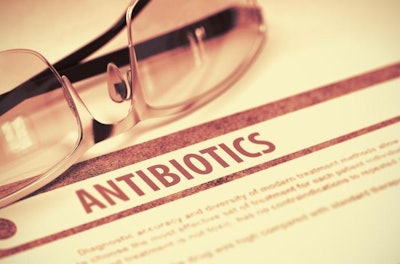
Despite the U.S. Food and Drug Administration’s (FDA) report that U.S. sales of antibiotics have dropped by one-third, it could be several years before experts are certain what the trend means for animal health or the spread of antibiotic-resistant bacteria.
According to the FDA’s December 2018 report, sales of antibiotics approved for use in food-producing animals dropped by 33% between 2016 and 2017 — the first full year of data available since the U.S. agency began to require a prescription, or Veterinary Feed Directive, for all antibiotics considered essential to human health.
“From where we stand, the data is really encouraging. But clearly, more needs to be done,” said Karin Hoelzer, a veterinarian and senior officer at Pew Charitable Trusts. The trend toward better antibiotic stewardship must continue, she said, but should include efforts to protect animal health as well.
Though overall sales of antibiotics decreased, sales of injectable, oral and topical antibiotics increased in 2017, pointing to a possible decline in overall animal welfare, according to Noelle Noyes, a veterinary epidemiologist and assistant professor at the University of Minnesota.
Sales of injectable antibiotics increased 3%, while sales of oral and topical drugs increased 5%. But the increase was offset by steep declines in the sales of antibiotics intended for use in water applications, which decreased 14%, and particularly by the decreased sale of antibiotics for animal feed, which dropped 43% in a single year.
“That’s not unexpected,” Noyes said. “We’ve seen in other countries where they implemented these regulations that if you take away more of the population-level antibiotic treatments, you get more overt sickness in individual animals and you start resorting to individual treatments of injectable drugs.”
More data needed
But sales data is not an ideal metric for monitoring animal health outcomes, Noyes said, because the FDA’s data does not include definitive information on how and why the antibiotics were used. Additional data collection is necessary to determine whether the FDA regulations have effectively reduced the growth of antibiotic-resistant bacteria, and whether the benefits outweigh any decline in animal welfare.
“We need to be looking at the larger picture,” Noyes said. “If antibiotic sales are going down in feed, does that mean we are seeing decreased use across all classes of antibiotics, or are we just shifting the antibiotics we’re using and the route of delivery?”
It’s also not clear from the data whether the trend was driven exclusively by U.S. regulatory actions, or whether it is also tied to consumer demand for antibiotic-free meat, according to Tara Smith, a professor of epidemiology at Kent State University. The FDA report notes that, although many widely used antibiotics were sold over the counter for animal use up to January 2017, the decline in antibiotic sales actually began the year prior. Sales peaked in 2015, and had dropped a total of 43% by the end of 2017.
Although the decreases appear to be a step in the right direction, Smith said, the overall reduction in sales was “not massive.” The U.S. continues to use large quantities of antibiotics to raise animals, she said, and decreases across specific industries have been uneven.
Sales of antibiotics for chickens, for example, were cut nearly in half, according to the FDA report — a dramatic decrease Smith tied to the poultry industry’s consumer-driven shift toward antibiotic-free production. Sales for turkeys, on the other hand, dropped by just 11%. Cattle and swine both saw a decrease of 35%.















